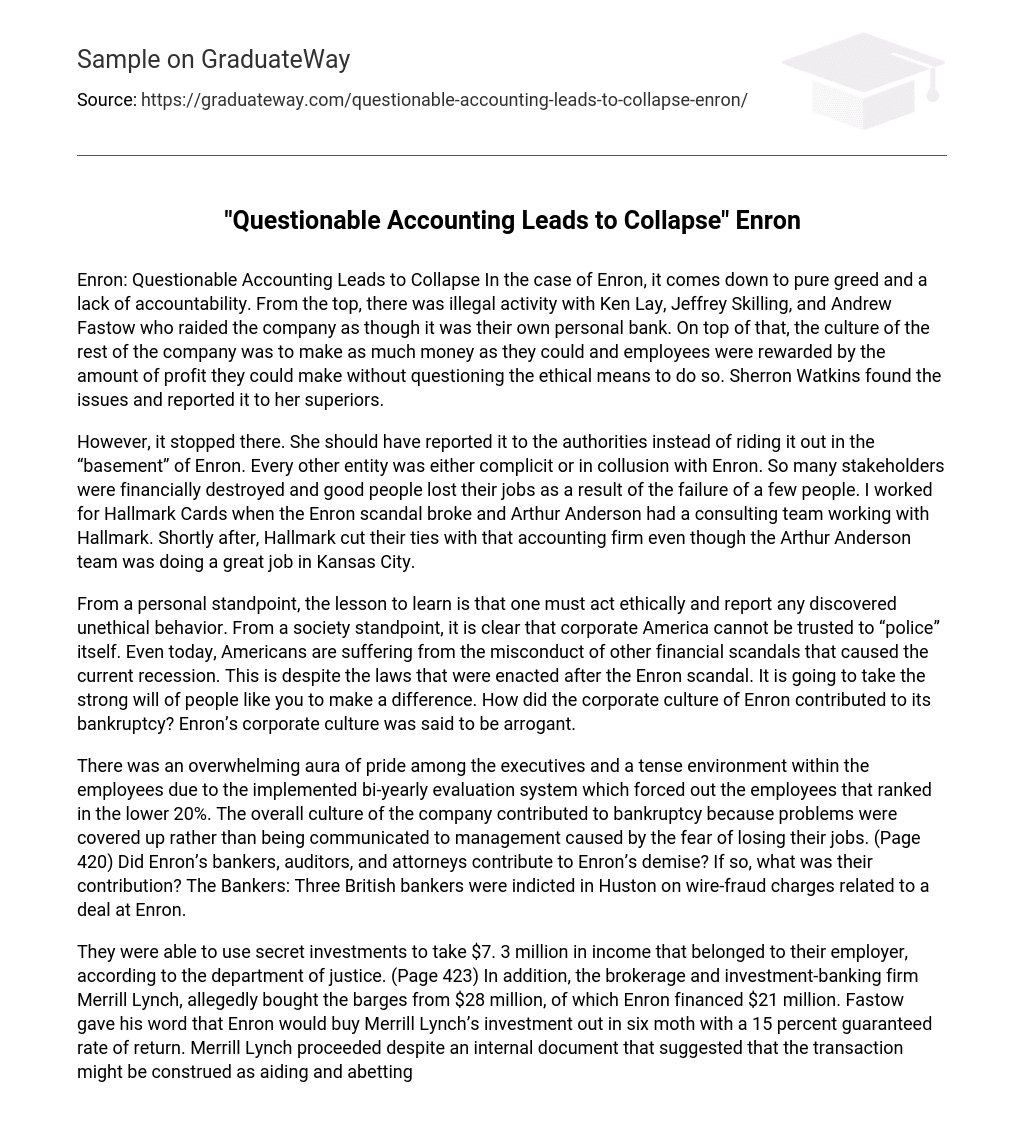Enron: Questionable Accounting Leads to Collapse In the case of Enron, it comes down to pure greed and a lack of accountability. From the top, there was illegal activity with Ken Lay, Jeffrey Skilling, and Andrew Fastow who raided the company as though it was their own personal bank. On top of that, the culture of the rest of the company was to make as much money as they could and employees were rewarded by the amount of profit they could make without questioning the ethical means to do so. Sherron Watkins found the issues and reported it to her superiors.
However, it stopped there. She should have reported it to the authorities instead of riding it out in the “basement” of Enron. Every other entity was either complicit or in collusion with Enron. So many stakeholders were financially destroyed and good people lost their jobs as a result of the failure of a few people. I worked for Hallmark Cards when the Enron scandal broke and Arthur Anderson had a consulting team working with Hallmark. Shortly after, Hallmark cut their ties with that accounting firm even though the Arthur Anderson team was doing a great job in Kansas City.
From a personal standpoint, the lesson to learn is that one must act ethically and report any discovered unethical behavior. From a society standpoint, it is clear that corporate America cannot be trusted to “police” itself. Even today, Americans are suffering from the misconduct of other financial scandals that caused the current recession. This is despite the laws that were enacted after the Enron scandal. It is going to take the strong will of people like you to make a difference. How did the corporate culture of Enron contributed to its bankruptcy? Enron’s corporate culture was said to be arrogant.
There was an overwhelming aura of pride among the executives and a tense environment within the employees due to the implemented bi-yearly evaluation system which forced out the employees that ranked in the lower 20%. The overall culture of the company contributed to bankruptcy because problems were covered up rather than being communicated to management caused by the fear of losing their jobs. (Page 420) Did Enron’s bankers, auditors, and attorneys contribute to Enron’s demise? If so, what was their contribution? The Bankers: Three British bankers were indicted in Huston on wire-fraud charges related to a deal at Enron.
They were able to use secret investments to take $7. 3 million in income that belonged to their employer, according to the department of justice. (Page 423) In addition, the brokerage and investment-banking firm Merrill Lynch, allegedly bought the barges from $28 million, of which Enron financed $21 million. Fastow gave his word that Enron would buy Merrill Lynch’s investment out in six moth with a 15 percent guaranteed rate of return. Merrill Lynch proceeded despite an internal document that suggested that the transaction might be construed as aiding and abetting Enron’s fraudulent manipulation of its income statement. Page 425) The Auditors: Arthur Andersen, LLP, was responsible for ensuring the accuracy of Enron’s financial statements and internal bookkeeping. Potential investors used Andersen’s repots to judge Enron’s financial soundness and future potential before they decided whether to invest. These investors expected that Andersen be independent and without any conflict of interest. If Andersen’s repots were in error, inventors could be seriously misled. However, Andersen was found guilty of obstruction of justice for destroying Enron-related auditing documents during and SEC investigation of Enron.
The accounting firm was a major business partner of Enron, with more than one hundred employees dedicated to its account, and it sold about $50 million a year in consulting services to Enron. (Page 425) The Attorneys: Huston’s law firm Vinson & Elkins were Enron’s attorney and according to Watkins’ allegations of accounting fraud Vinson & Elkin’s helped structure some of Enron’s special-purpose partnerships and they wrote opinion letters supporting the legality of the deals. In fact, Enron could not have done many of the transactions without such opinion letters. Page 424) What role did the chief financial officer played in creating the problems that lead to Enron’s financial problem? The Chief Financial Officer was the brain behind the partnerships used to conceal some $1 billion in Enron debt and that this led directly to Enron’s bankruptcy. Fastow plead guilty to two counts of conspiracy, admitting to orchestrating myriad schemes to hide Enron debt and inflate profits while enriching him with millions. (Page 422) Ferrell, Fraedrich, & Ferrell (2011). Business Ethics: Ethical Decision Making And Cases (8th ed. ). Canada: South-Western, Cengage Learning





